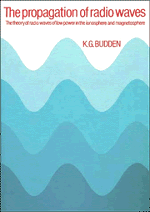 The Propagation of Radio Waves
The Propagation of Radio Waves Book contents
- Frontmatter
- Contents
- Preface
- 1 The ionosphere and magnetosphere
- 2 The basic equations
- 3 The constitutive relations
- 4 Magnetoionic theory 1. Polarisation and refractive index
- 5 Magnetoionic theory 2. Rays and group velocity
- 6 Stratified media. The Booker quartic
- 7 Slowly varying medium. The W.K.B. solutions
- 8 The Airy integral function and the Stokes phenomenon
- 9 Integration by steepest descents
- 10 Ray tracing in a loss-free stratified medium
- 11 Reflection and transmission coefficients
- 12 Ray theory results for isotropic ionosphere
- 13 Ray theory results for anisotropic plasmas
- 14 General ray tracing
- 15 Full wave solutions for isotropic ionosphere
- 16 Coupled wave equations
- 17 Coalescence of coupling points
- 18 Full wave methods for anisotropic stratified media
- 19 Applications of full wave methods
- Answers to problems
- Bibliography
- Index of definitions of the more important symbols
- Subject and name index
14 - General ray tracing
Published online by Cambridge University Press: 06 December 2010
- Frontmatter
- Contents
- Preface
- 1 The ionosphere and magnetosphere
- 2 The basic equations
- 3 The constitutive relations
- 4 Magnetoionic theory 1. Polarisation and refractive index
- 5 Magnetoionic theory 2. Rays and group velocity
- 6 Stratified media. The Booker quartic
- 7 Slowly varying medium. The W.K.B. solutions
- 8 The Airy integral function and the Stokes phenomenon
- 9 Integration by steepest descents
- 10 Ray tracing in a loss-free stratified medium
- 11 Reflection and transmission coefficients
- 12 Ray theory results for isotropic ionosphere
- 13 Ray theory results for anisotropic plasmas
- 14 General ray tracing
- 15 Full wave solutions for isotropic ionosphere
- 16 Coupled wave equations
- 17 Coalescence of coupling points
- 18 Full wave methods for anisotropic stratified media
- 19 Applications of full wave methods
- Answers to problems
- Bibliography
- Index of definitions of the more important symbols
- Subject and name index
Summary
Introduction
Ch. 10 studied the problem of ray tracing in a plane stratified medium. The objective of the present chapter is to extend this theory to deal with media that are not plane stratified. For example the composition of the ionosphere nearly always depends on the horizontal coordinates, and there are cases especially near twilight when it cannot be assumed to be horizontally stratified. The structure of the magnetosphere is controlled largely by the earth's magnetic field and the solar wind, see § 1.9, and it is not plane stratified.
The number of published papers on ray tracing methods is very large and the subject has acquired some mathematical interest that often goes beyond the needs of practical radio engineers. In this book no attempt has been made to give all the references, but a few that have come to the author's attention are given at the relevant points in this chapter. The objective here is to present the basic physical ideas of ray tracing and to describe the methods that have mainly been used for radio waves in the ionosphere and magnetosphere.
In § 10.2 the ray path was expressed by integrals (10.3), and for plane stratified media these can often be evaluated in closed form. For the more general plasma, however, this is rarely possible. The ray path was also expressed by its differential equations (10.5) for dx/dz, dy/dz.
- Type
- Chapter
- Information
- The Propagation of Radio WavesThe Theory of Radio Waves of Low Power in the Ionosphere and Magnetosphere, pp. 400 - 437Publisher: Cambridge University PressPrint publication year: 1985
